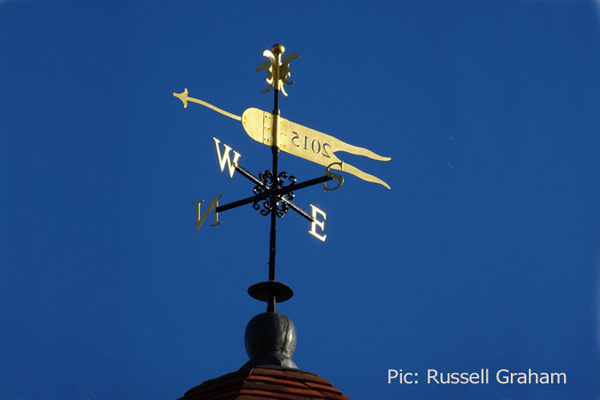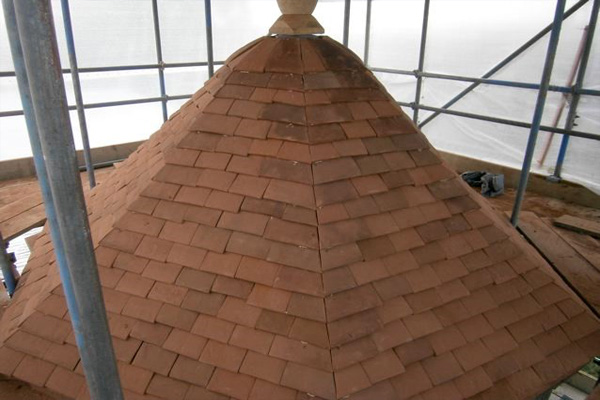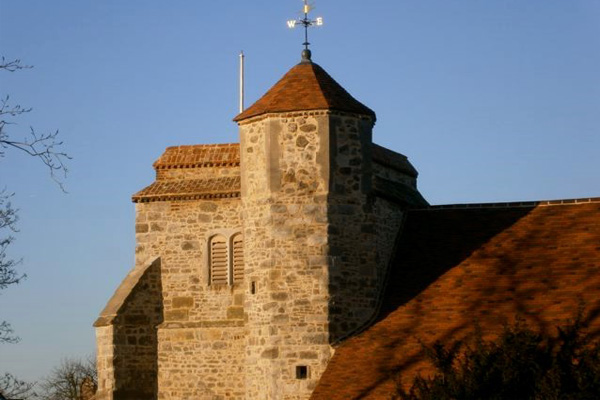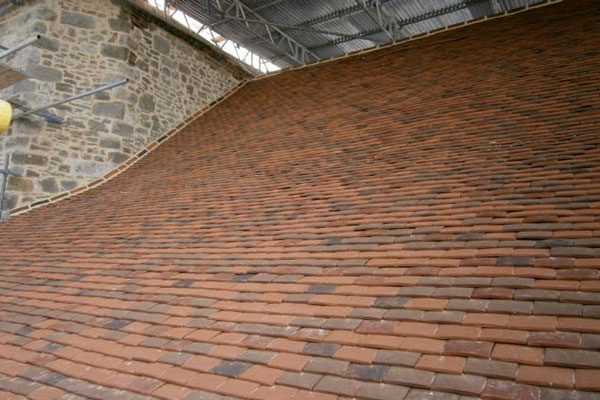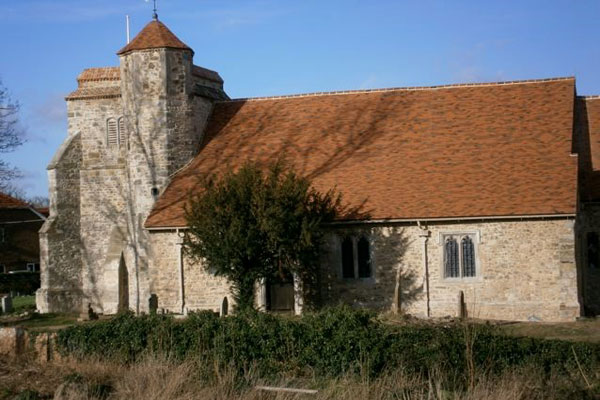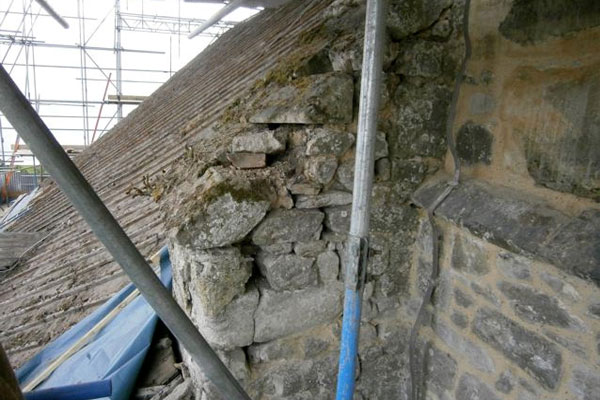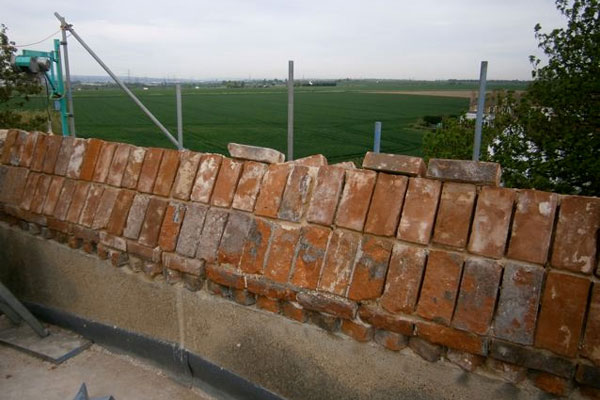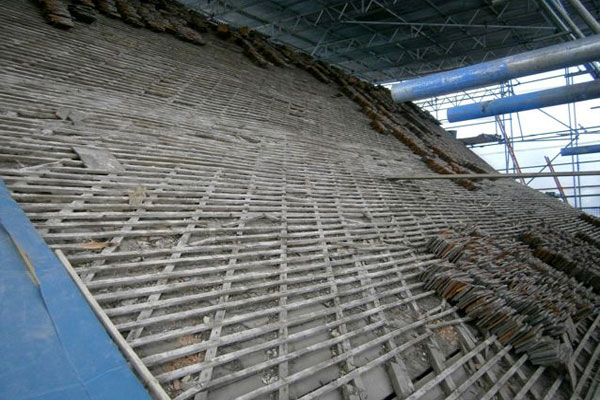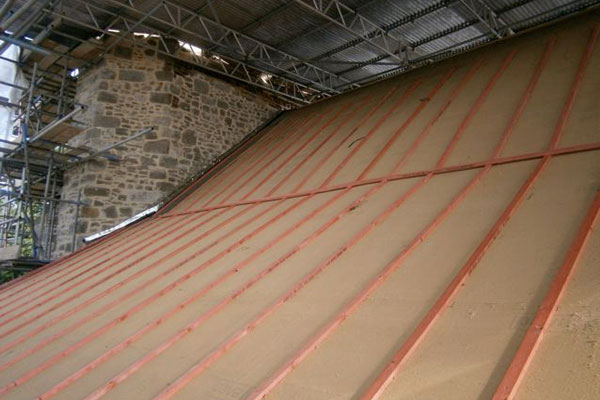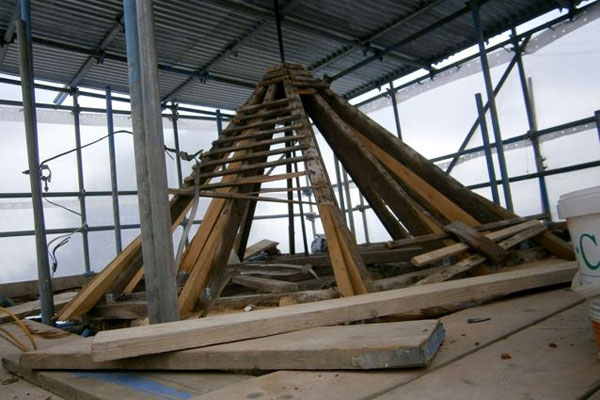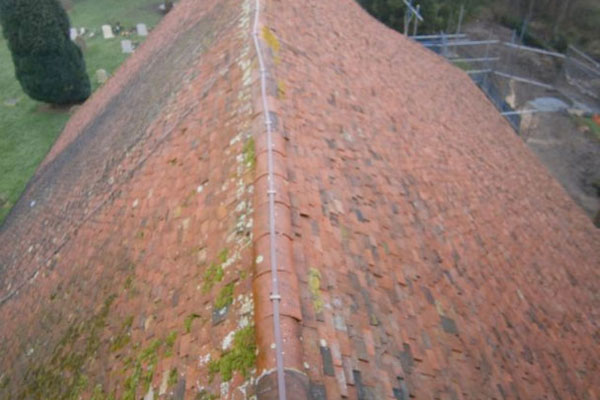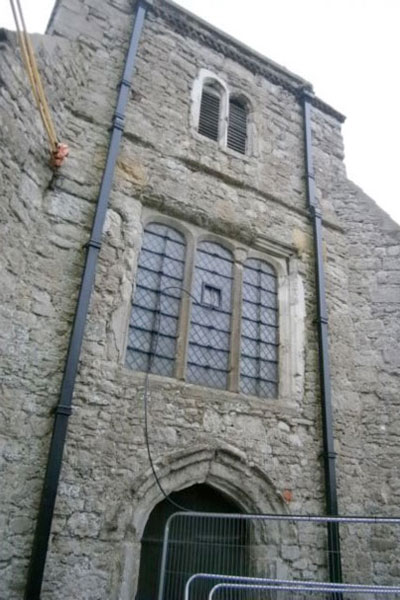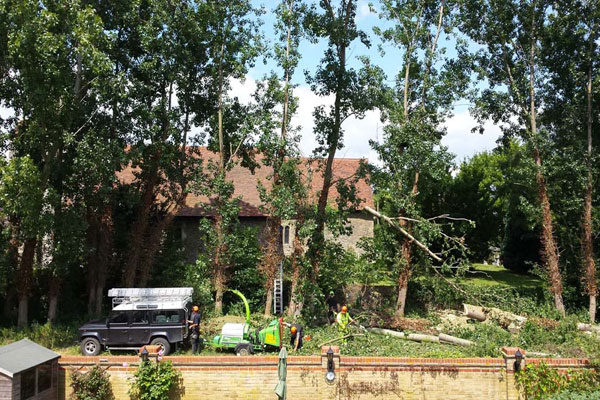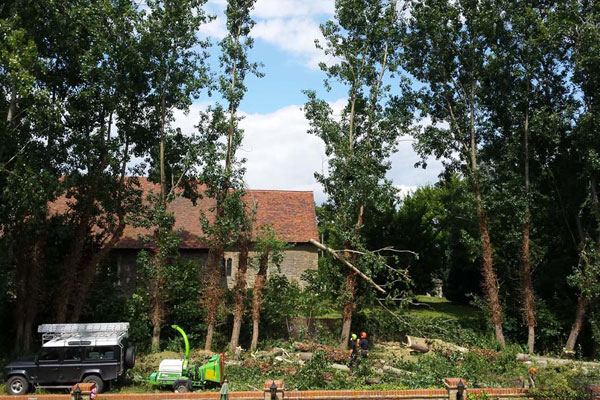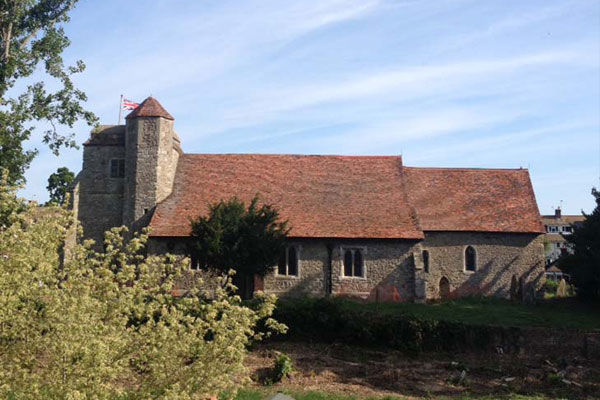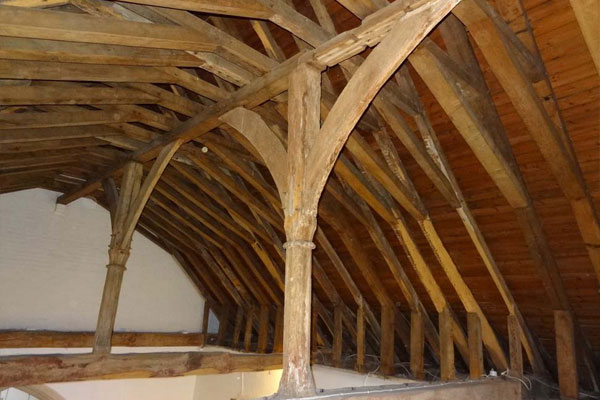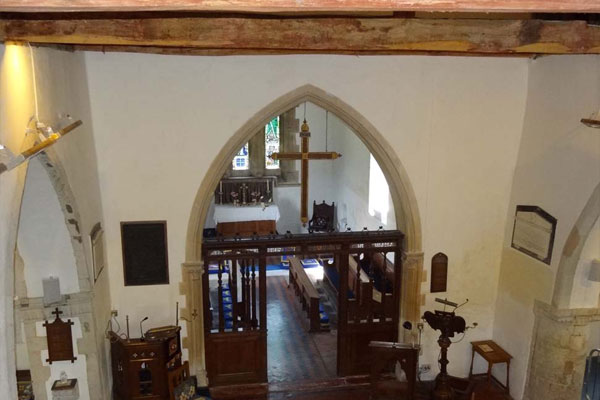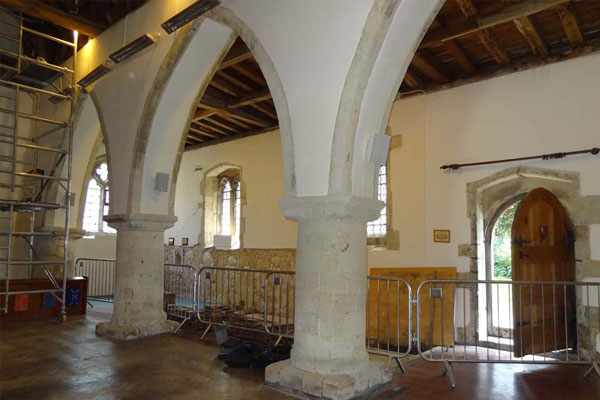Phase 2 Project
Reroof the nave and turret – Extensive stonework repairs to the tower – install an accessible toilet within the church.
1. State of the Church
The underpinning of the south aisle and associated stonework repairs have been completed.
The Quinquennial inspection of the church by Mrs Rena Pitsilli-Graham, church architect, was carried-out in September 2012.
Apart from the movement of the south aisle, it was noted that the state of the nave roof Kent-peg tiles were in poor condition, with many of the nails rusted away.
The tower showed signs of weathering and was in need of attention to preserve the ancient stonework.
A large storage cupboard inside the church was identified as a suitable place to install an accessible toilet.
2. Reroofing Nave and Turret
After the erection of extensive scaffolding, including a corrugated sheet roof, work was able to start off the Kent-peg tiles. Then, following that, the old batons and felt insulation were removed to expose the timbers underneath.
The timbers were inspected by a structural engineer who made minor repairs to the ends of the timbers in the nave. Replacement timbers were need in the south aisle roof. Whilst the timbers were exposed a dendrochronologist was employed to date the wood. Unfortunately, he was unable to date the south aisle, (through lack of rings). He dated the main timbers as being constructed between 1557 and 1589. Some beams had been either repaired or reconstructed between 1757 and 1789.
Following the repairs mentioned above, the new batons and counter batons were laid and a 35mm sarking board was laid on the whole roof. New Kent-peg tiles, of four different colours, were laid to match the old roof. The guttering and downpipes were adjusted and painted. The turret roof was treated in a similar way with the addition of extra strengthening timbers. Fittings were put in place for a new weathervane.
3. The Tower
The tower, which was built in the 16th century, was showing obvious signs of weathering with some of the stonework crumbling away.
Clearing and pointing work was carried-out on the tower. However, on inspection, two of the buttresses needed rebuilding; Kentish ragstone had to be used. The stone was quarried near Maidstone only twenty miles from the church.
At the top of the tower, surrounding the flat roof, the concrete screed was taken off to reveal red brickwork. The damaged bricks were replaced but many of the original bricks were cleaned and left in place. A conservator was employed to preserve the surrounds of the west window and door.
4. Cloakroom
In order to encourage children and adult groups to visit the church, the PCC decided that a cloakroom was necessary. With a few alterations, the large broom cupboard, just inside the main door, was big enough to be converted to an accessible area with toilets and basins, including facilities for the disabled. The space above houses the water heater. The water connection and the waste pipe were laid on the verge to the west side of the pathway to the church and connected to the services in the highway. The floor in the cloakroom was tiled to match the tiles in the church.
5. Funding
The PCC is very grateful for the sizeable grant from the Heritage Lottery Fund, without which the project would not have been possible.
We also received grants from WREN (landfill tax), Friends of Kent Churches and the Wolfson Foundation. These, together with many private donations, have funded the project.
The congregation members have raised funds by having coffee mornings and a strawberry tea.
6. Outreach
Since the project started in April 2015, almost 1600 people have been into the church for services, meetings and open days. We could not have envisaged such a large number of visitors when we had our first meeting with HLF in December 2012.
We have kept in touch with the villagers through regular updates in the “Village Voices” magazine that is published monthly. We held a very successful Open Day in October attracting over 120 people to see photographic exhibits of the work. Visitors were also able to climb to the top of the tower to look at the new roof and to see the wonderful panoramic view of the countryside. In the coming months we have the AGM of the Friends of Kent Churches and three weddings already booked.
7. Summary
We managed to obtain funding to reroof the channel and re-plaster the inside of the chancel. Since the last refurbishment in 1898, the church is now fully restored and the building preserved for many generations to come.
All of the restorations have been made possible by the expertise of the professionals involved and the skill of the builders themselves. None of this could have happened without the generosity of HLF and many others.
Update – August 2015
Following the completion of Phase One of the restoration programme, the church moved onto Phase two, which included the re-roofing of the nave and the porch, extensive stonework repairs to the west tower and the installation of an accessible toilet within the church.
Scaffolding was erected around the church in April, together with a tin shelter roof over the nave to protect the roof during the removal of the tiles. The scaffolding was all sheeted to keep the church waterproof.
Work started on the turret of the west tower to remove the concrete covering the brickwork to reveal the red bricks that were hidden. The broken ones were replaced and the better ones re-pointed.
Whilst this was being done, grouting and pointing of the stonework was being done at high levels. Deterioration of some buttresses made it necessary to rebuild them and in some places, to introduce new Kentish ragstone, (quarried near Maidstone).
At the end of April and the beginning of May, tiles were taken off the roof and the roof was stripped of batons and old felt. This enabled access to the roof timbers so that the repairs and replacements could be carried out both inside and outside the church.
The roof was then covered with scarping board and the new batons were fixed. New Kent peg tiles, of four different shades, matching the original tiles, were fixed on the nave roof and the porch. The seven-sided turret at the top of the church is being strengthened for a weather vane to be fitted. The turret will then be retiled.
Update – 13 March 2015
Despite the problems caused by the presence of bats, which delayed the start of the underpinning and stonework project the underpinning is now completed! There are 13 piles drilled down to a depth of 19 metres in places (that’s 62 feet – the same size as a tall adult giraffe!) at various strategic places – some are inside the church but most are outside. A concrete beam has been laid to join the various clusters of piles. Following that, the foundations of the South Aisle were drilled out with metal props inserted to hold the wall up! A steel framework was then inserted and filled with concrete to make a continuous beam under the aisle. This should prevent any further movement of the building despite the London clay underneath.
Three church windows have been taken out and repaired and the grilles protecting them repointed and painted. Old mortar has been cleaned from the stonework and replaced with a new mortar mix. Other parts of the fragile wall have been taken down and replaced.
The church has just been informed that the they have been given a very generous grant of £215,000 from the Heritage Lottery Fund to enable the church to be reroofed, have extensive repairs to the ancient tower and install an accessible toilet within the church – very handy for the extra visitors the church is now attracting! It is hoped this work can start in the very near future on our next project phase which will preserve the church for generations to come. (Pictures: Ian Bett)
It was in 1898 that Stoke Church had its last major overhaul. Since then regular maintenance has been carried out to maintain the building.
The church is built on London clay which has a habit of moving when it gets very dry. Over the last fifteen years the movement has worsened with the effect that the South aisle of the church, which was added about 100 years after the main church was built, has moved away from the main building. This has caused cracking in the stonework and disturbance to the roof.
A plan has been devised to underpin the aisle using concrete beams supported by piles, driven 15 meters into the ground, and to carry out urgent stone work repairs. Preliminary investigations carried out by archaeologists have found a double vault inside the aisle, the footings of the original church before the tower was built and burial sites near to the church outer walls. Positioning the piles to avoid important archaeology is an interesting puzzle.
The work was scheduled to start in late June 2013 but the discovery of Pippistelle bats has delayed the work until after their breeding season (May to September). The underpinning work will start in late September 2014 and the stonework repairs will follow this. At the same time plans are underway to reroof the church, carry out stonework repairs to the tower and to install an accessible toilet within the church.
Since 2013 the PCC of the church of St. Peter and St. Paul Upper Stoke, Kent has been working with architect Rena Pitsilli-Graham. Together they have researched and investigated the history and current structural needs of the church to inform the successful bids to the Heritage Lottery Fund. Here is Ian and Renas’ restoration diary…
Below are some pictures of the poplar trees being cut down by the boundary wall behind the church in June 2014, removed because their roots were drawing out ground moisture leading to damage to the church building and causing subsistence. (Pictures left and middle, J Plumb, picture right Phillipa Bett)
The roof posts are King posts; they should have had 4 braces (branches) but 2 were removed for some reason, probably in the 1898 restoration which replaced most of the rafters. The king posts and the tie beams on which they sit are early timbers date to be hopefully ascertained by dendrochronology when we start work in 2014, (Pictures below Rena Pitsilli-Graham).



